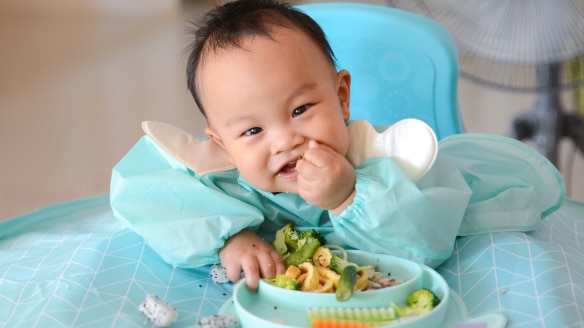Complementary Feeding Methods: Overview & Definitions
1 min read • By: Gerber Medical Hub

Quick summary
Learn about how complementary feeding is defined, including spoon-feeding, baby-led weaning, and baby-led feeding.
Parents and caregivers have a variety of methods to choose from when feeding their baby. Although caregivers most often combine methods to implement what works best for them and their families, there are three main methods being practiced: Spoon-Feeding, Baby-Led Weaning, and Baby-led feeding.
Spoon-Feeding
Spoon-Feeding is the approach of spoon-feeding purees first (Brown 2016). Following purees, gradually increase the texture from puree to mash, to lumpy. Next, gradually shift towards family foods with babies feeding themselves finger foods alongside the spoon-feeding journey (Cameron 2013), following the baby’s age and developmental progress (D’Auria 2018).
- Examples of foods for spoon-feeding include iron-fortified infant cereals, baby food purees made from nutrient dense foods such as vegetables, fruits, meats, grains, yogurt. Purees may range from smooth to mashed or lumpy.
- Gerber’s Guide to Starting Solids can help parents and caregivers learn how to start spoon feeding.
Baby-Led Weaning (BLW)
Baby-Led Weaning (BLW) is a feeding method that involves allowing babies to feed themselves solid foods from the start of weaning (D’Auria 2018). In BLW, babies are offered a variety of finger foods that they can pick up and eat on their own. There is no standardized definition of BLW. Many parents are interested in offering foods for self-feeding but also offering foods using spoon-feeding. This hybrid method is a form of baby-led feeding.
- To get started with BLW, follow these five steps. Encourage your patients to use safe utensils with their babies, such as a baby-safe spoon with Gerber Purees.
Baby-Led Feeding
Baby-led feeding or combination feeding refers to combining spoon-feeding and BLW, taking the best bits from both methods. One version of this method has been studied in New Zealand as a randomized controlled trial, Baby-Led Introduction to Solids (BLISS), in which participants had professional lactation consultant service and nutrition education (Daniels 2015). Parents were encouraged to offer three food types at each meal:
- An iron-rich food (e.g., red meat, iron fortified infant cereal)
- An energy-rich food (e.g., avocado, cheese)
- An easy-to-eat food such as a fruit or vegetable
References
- Brown A. Differences in eating behaviour, well-being and personality between mothers following baby-led vs. traditional weaning styles. Matern Child Nutr. 2016 Oct;12(4):826-37.
- Cameron SL, et al. Parent-led or baby-led? Associations between complementary feeding practices and health-related behaviours in a survey of New Zealand families. BMJ Open. 2013;3.
- Daniels L, et al. Baby-Led Introduction to SolidS (BLISS) study: a randomised controlled trial of a baby-led approach to complementary feeding. BMC Pediatr 15, 179 (2015).
- D'Auria E, et al. Baby-led weaning: what a systematic review of the literature adds on. Ital J Pediatr. 2018 May 3;44(1):49



